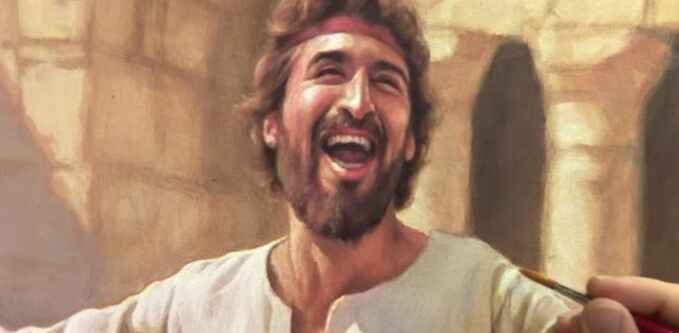- You are here:
- Home »
- Blog »
- Written Tutorial »
- How To Use Contrast And Vibrancy: Acrylic Grisaille Technique

How To Use Contrast And Vibrancy: Acrylic Grisaille Technique
Unlock the secrets to dynamic paintings with the acrylic grisaille technique
Discover how to bring your portrait to life with vibrant contrasts and nuanced details using the acrylic grisaille technique.
In the realm of acrylic painting, learning the art of contrast and vibrancy can elevate your work to new heights. In this tutorial, we delve into the acrylic grisaille technique, a method that adds depth, richness, and dynamic energy to your paintings. Follow along as we explore the final steps in creating a painting of King David dancing as the Arc of the Covenant returns to Jerusalem.
What is the acrylic grisaille technique?
The acrylic grisaille technique begins with a monochromatic underpainting, typically done in shades of gray or sepia. This foundation allows artists to focus on values and contrasts without the distraction of color. Once the grisaille layer is complete, transparent glazes of color are applied, building up layers to create a rich and vibrant final image.
Enhancing Contrast and Vibrancy
In this demonstration, the artist uses a variety of techniques to enhance the contrast and vibrancy of the painting:
- Adding Halation for Vibrancy: Halation involves adding vibrant colors to the areas where bright highlights meet darker tones. By mixing organic orange, Indian yellow, and titanium white, the artist creates a glowing effect that makes the white clothing of King David pop against the background.
- Layering Glazes: Multiple glazes of color are applied over the sepia-toned underpainting. This layering process builds depth and richness, allowing the artist to fine-tune the vibrancy of the painting.
- Nuanced Details: Small round brushes are used to add intricate details and highlights, particularly in areas of high contrast. These details draw the viewer’s eye and add a sense of realism and movement to the painting.

Step-by-Step Process
- Prepare the Underpainting: Start with a monochromatic sepia tone. Focus on establishing the values and contrasts that will guide the final image.
- Mix Vibrant Colors: Create a mix of organic orange, Indian yellow, and titanium white. Adjust the strength of the color to suit the desired level of vibrancy.
- Apply Halation Effects: Carefully apply the vibrant mix to the edges of bright highlights. This technique enhances the contrast and makes the lighter areas stand out more vividly.
- Layer Glazes: Apply transparent glazes over the underpainting. Use a combination of colors to build depth and richness, allowing each layer to dry before adding the next.
- Add Nuanced Details: Use small brushes to add highlights and details. Focus on areas of high contrast to draw the viewer’s eye and add a sense of movement and realism.
Final Touches
The final steps involve signing the painting and adding any last-minute highlights or details. The artist emphasizes the importance of placing the signature in a way that complements the composition, ensuring it is visible but not intrusive
By learning the acrylic grisaille technique, you, as artists, can create paintings that are not only visually striking but also rich in depth and detail. Whether you are a seasoned artist or a beginner, these tips and techniques will help you bring your portrait to life.
For more detailed tutorial, watch the video below: Finishing the Painting of King David Dancing in Jerusalem (Acrylic Grisaille Technique)
LEARN MORE
- Sketching Your Painting Accurately
- Beginning a Pet Portrait in Acrylic
- The Mystery of Realism in Painting
- Apply A Burnt Sienna Glaze to a Portrait
- Learn How to Sketch a Portrait Freehand in 45 Minutes
- Adding highlights to your acrylic painting
- 5 Excellent Reasons to Use Aluminum Foil
- Paint Realistic Wrinkles in Acrylic
- Painting Clothing in an Acrylic Portrait
- Paint a Cloudy Sky Acrylic
- How to add Semi-Opaque Highlights
- How to Enhance the Contrast in Your Acrylic
- How to Add Glaze to Your Acrylic Painting
- Paint Realistic Reflections on Eyeglasses in an Acrylic Portrait
- Build Up Depth on Your Acrylic Portrait Backgrounds
- How Do You Do Layers With the Glazing Technique?
- Learn How to Paint Wrinkles in Acrylic
Read more about how to paint a portrait that you can surely be proud of!
I’d love to hear your thoughts on this video. Please share it with your friends and family. Let me know if you have any further questions. I’ll greatly help you.
If you’d like to learn more, sign up for my free email tips and video class today.
Learn How to Paint Acrylic Portraits With My Free Mini-Video Course!Thank you so much for taking the time to read this tutorial and watch the video. That means a lot to me. I hope you find it very helpful in your portrait painting.
Yours for Better Portraits,
P.S. Did you find this post helpful or encouraging? If so, send it in ahead! Let others know with the share buttons below. I’d love to hear your comments. Thank you so much! Also, do you have a question on acrylic portrait painting you’d like answered? Let me know, and I’d be happy to help!
